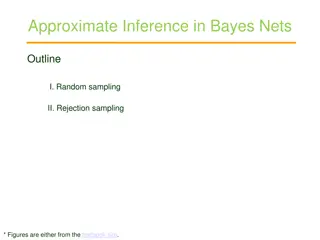Introduction to Sampling in Statistics
Sampling in statistics involves selecting a subset of individuals from a population to gather information, as it is often impractical to study the entire population. This method helps in estimating population characteristics, although it comes with inherent sampling errors. Parameters represent population characteristics, while statistics summarize data from samples. The main objectives of sampling are to maximize information about the population with minimal effort and to assess the accuracy of estimates based on samples.
Download Presentation

Please find below an Image/Link to download the presentation.
The content on the website is provided AS IS for your information and personal use only. It may not be sold, licensed, or shared on other websites without obtaining consent from the author.If you encounter any issues during the download, it is possible that the publisher has removed the file from their server.
You are allowed to download the files provided on this website for personal or commercial use, subject to the condition that they are used lawfully. All files are the property of their respective owners.
The content on the website is provided AS IS for your information and personal use only. It may not be sold, licensed, or shared on other websites without obtaining consent from the author.
E N D
Presentation Transcript
INTRODUCTION Often we are interested in drawing valid conclusion about a large group of individual or object. This group of individuals under study is called population or universe. Instead of examining the entire group of individual or population, which may be difficult or impossible to do, we may examine only a small part of this population, which is called sample.
Thus in statistics Population: is an aggregate of objects, animate or inanimate, under study. The population may be finite or infinite. For any statistical enumeration of the population is not feasible and a very difficult task. If the population enumeration is not possible. investigation complete is infinite, complete
Sample: A finite subset of statistical individuals in a population is called a sample and the number of individuals in a sample is called the sample size. For the purpose of determining population characteristics, instead of enumerating the entire population, the individuals in the sample only are observed. Then the sample characteristics are utilized to approximately determine or estimate the population.
The error involved in such approximation is known as sampling error and is inherent and unavoidable in any and every sampling scheme. But sampling results in considerable gains, especially in time and cost not only in respect of making observations of characteristics but also in the subsequent handling of the data.
The main objects of sampling are: To obtain maximum information about the population with minimum effort; and To state the accuracy of estimate based on sample.
Parameter & statistics In simple words, a parameter is any numerical quantity that characterizes a given population or some aspect of it. This means the parameter tells us something about the whole population. Statistics are numbers that summarize data from a sample. For instance, suppose we selected a random sample of 100 students from a school with 1000 students. The average height of the sampled students would be an example of a statistic.
For each study, identify both the parameter and the statistic in the study. A researcher wants to estimate the average height of women aged 20 years or older. From a simple random sample of 45 women, the researcher obtains a sample mean height of 63.9 inches. Ans: The parameter is the average height of all women aged 20 years or older. The statistic is the average height of 63.9 inches from the sample of 45 women.
Eg.2 A nutritionist wants to estimate the mean amount of sodium consumed by children under the age of 10. From a random sample of 75 children under the age of 10, the nutritionist obtains a sample mean of 2993 milligrams of sodium consumed. Ans: The parameter is the mean amount of sodium consumed by children under the age of ten. The statistic is the mean of 2993 milligrams of sodium obtained from the sample of 75 children.
Eg.3 A researcher wants to estimate the average farm size in Kansas. From a simple random sample of 40 farms, the researcher obtains a sample mean farm size of 731 acres. Ans: The parameter is the average farm size in Kansas. The statistic is the mean farm size of 731 acres from the sample of 40 farms.
Eg.4 An energy official wants to estimate the average oil output per well in the United States. From a random sample of 50 wells throughout the United States, the official obtains a sample mean of 10.7 barrels per day. Ans: The parameter is the average oil output per well in the United States. The statistic is the mean oil output of 10.7 barrels per day from the sample of 50 wells.
Eg.5 The International Dairy Foods Association (IDFA) wants to estimate the average amount of calcium male teenagers consume. From a random sample of 50 male teenagers, the IDFA obtained a sample mean of 1081 milligrams of calcium consumed. Ans: The parameter is the average amount of calcium that male teenagers consume. The statistic is the mean of 1081 milligrams of calcium from the sample of 50 teenagers.
Eg.6 A school administrator wants to estimate the mean score on the verbal portion of the SAT for students whose first language is not English. From a simple random sample of 20 students whose first language is not English, the administrator obtains a sample mean SAT verbal score of 458. Ans: The parameter is the mean verbal SAT score for students whose first language is not English. The statistic is the mean SAT verbal score of 458 from the sample of 20 students.
Sampling Distribution of a Statistic: If we draw a sample of size n from a given finite population of size N, then the total number of possible samples is: (say).
For each of these k samples we can compute some statistic t = t(x1,x2,... ,xn), in particular the mean ?, the variance s2,etc., as given below: Sample Number Statistics ? s2 t s21 1 t1 x1 s22 2 t2 x2 s23 3 t3 x3 . . . . . . . . s2k k tk Xk
The set of the values of the statistic so obtained, one for each sample, constitutes what is called the sampling distribution of the statistic. For example the values t1,t2,t3, . ., tkdetermine the sampling distribution of the statistic t. In other words, statistic t may be regarded as a random variable which can take the values t1,t2,t3, . ., tkand we can compute the various statistical constants like mean, variance, skewness, kurtosis etc., for its distribution.
Standard Error: The standard deviation of the sampling distribution of a statistic is known as its Standard Error, abbreviated as (S.E.). The standard error gives a measure of dispersion of the concerned statistic. It depends on the sample size n and goes on decreasing as the sample size increases.
The standard deviation (SD) measures the amount of variability, or dispersion, for a subject set of data from the mean, while the standard error of the mean (SEM) measures how far the sample mean of the data is likely to be from the true population mean.
Since the population standard deviation is seldom known, the standard error of the mean is usually sample standard deviation divided by the square root of the sample size (assuming statistical independence of the values in the sample). n is the size (number of observations) of the sample. estimated as the
What is a finite population? Finite Population Multiplier: A factor used to correct the standard error of the mean for studying a population of finite size that is small in relation to the size to the sample. A population is an entire set of individuals or objects, which may be finite or infinite. Examples of finite populations include the employees of a given company, the number of airplanes owned by an airline, or the potential consumers in a target market.
Finite Population Multiplier A factor used to correct the standard error of the mean for studying a population of finite size that is small in relation to the size to the sample.
The standard errors of some of the well-known statistics, for large samples are given below, where n is the sample size, ( 2) the population variance, and P the population proportion, and Q = 1 P, n1and n2 represent, the sizes of two independent random samples respectively drawn from the given population(s).
TH A N K YO U

























